Seville's signature sound: The Flamenco experience
In Seville, the pearl of Andalusia, flamenco thrives, with its pulsating rhythms and fiery footwork captivating audiences


Seville"s soul beat beneath my feet. Not literally, of course, but the rhythmic tapping that echoed through the Flamenco Dance Museum was enough to send shivers. This wasn"t just any performance venue—it was the only one of its kind, in a vault, in the city. Roman stones formed the foundation, while the intimate seating brought the audience face-to-face with the raw passion unfolding on the stage. The worn wooden platform, dented with the history of countless performances, served as a canvas that night. The performers, their bodies taut with emotion, transformed it within minutes. One moment, their rapid-fire footwork sent a jolt of energy through the room, capturing the fiery spirit of flamenco. Then, with a flick of a wrist and a dip of a head, the tempo slowed, the dancers conveying a deep, melancholic longing through their graceful movements. Sixty minutes in front of that stage felt like an emotional odyssey.
Every ten minutes, a new story unfolded, told not through words but through the language of the body. The dancers painted a vivid picture, from the uninhibited joy of a fiesta to the quiet sorrow of lost love. The raw passion, the rhythmic stomping, the anguish and defiance in their gaze—it was more than a performance, it was a story told through the language of the body and soul.
Seville, Andalusia, and the entirety of Spain proudly showcase flamenco as a heritage, yet often leave its deeper story untold. The Museo del Baile Flamenco, the first and only museum in the world dedicated to the art, was established to bridge this gap, offering visitors a comprehensive understanding of flamenco"s history and its true essence. The Flamenco Dance Museum, part of the Museo del Baile Flamenco, is housed in an 18th-century palace just a short distance from the Cathedral. It was founded in 2006 by Cristina Hoyos Panadero, a legend in her own right.
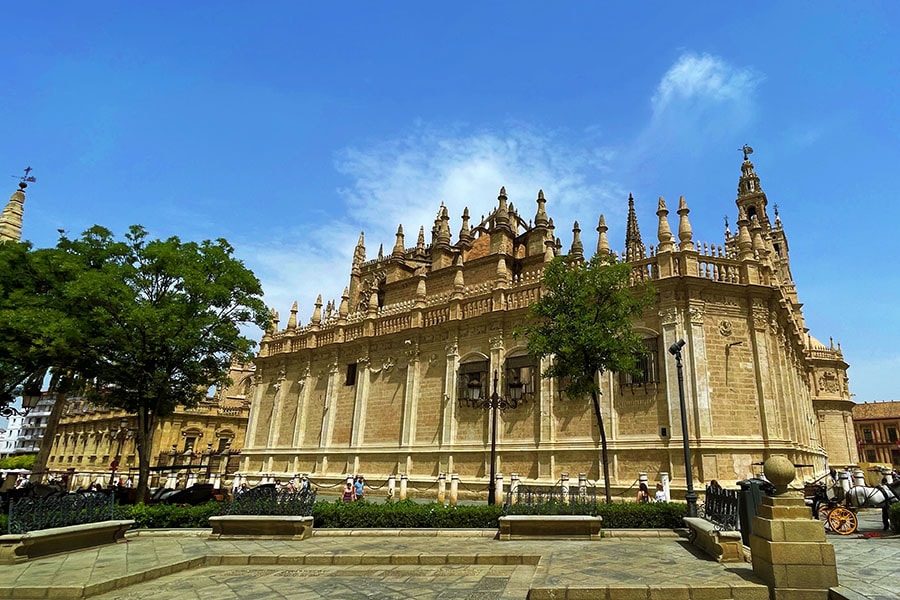 The Royal Alcà¡zar of Seville, a historic royal palace, stands on the site of a 10th-century Islamic-era citadel. It was expanded into a grand palace complex by the Abbadid dynasty in the 11th century and the Almohads in the 12th century. Image: Veidehi Gite
The Royal Alcà¡zar of Seville, a historic royal palace, stands on the site of a 10th-century Islamic-era citadel. It was expanded into a grand palace complex by the Abbadid dynasty in the 11th century and the Almohads in the 12th century. Image: Veidehi Gite
“We envisioned a dancer"s face with a coral earring, flowers in her bun, and all the intricate details, but we couldn"t get permission to display this on a faà§ade in Seville. Next, we planned to create a garden on the first floor, with a tree growing out of the terrace, but that idea was also denied. Determined not to be without a tree, we decided to hang them in the patio instead, alongside bulrush chairs, as a tribute to both the public and the artists." says Hoyos. Once seated, look up at the sky and you’ll be surprised to see “enea" chairs and Sevillian orange trees seemingly floating above you. The cast of artists changes daily, offering a dynamic experience. One day, you might witness “Alegràas" performed with a bata de cola, shawl, or castanets, while another day features the solemn “Seguiriya", a flamenco “Soleà¡ por Buleràas", the tragic “Taranto", the sensual “Tangos", or any of the diverse styles that make up this fascinating art form.
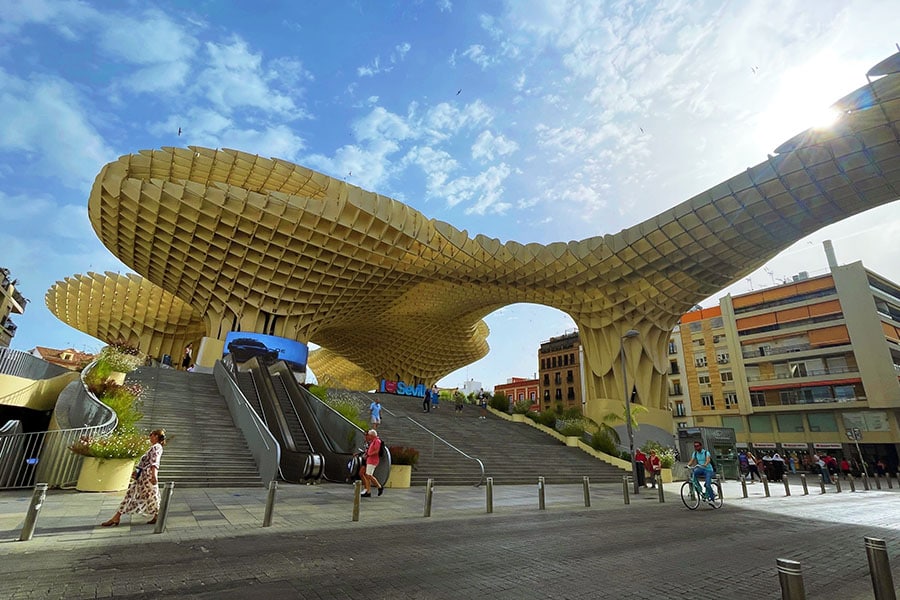 "Las Setas de Sevilla," also known as Metropol Parasol, is the largest wooden structure in the world, measuring 150 by 70 meters and standing 26 meters tall. Image: Veidehi Gite
"Las Setas de Sevilla," also known as Metropol Parasol, is the largest wooden structure in the world, measuring 150 by 70 meters and standing 26 meters tall. Image: Veidehi Gite
My exploration of Seville, the largest city in Andalusia, wasn"t a typical tourist itinerary. Sure, the iconic landmarks and lively plazas were on my list, but I craved a deeper dive into the city"s soul—flamenco. My journey began not with a stage performance, but with the artistry behind the stunning costumes. I met with the city"s renowned flamenco designers Pablo Retamero and Juanjo Bernal, their studios humming with dresses in silk, organza and cotton that would soon be twirling on stages and across events around the world. Retamero and Bernal have been creating flamenco dress outfits, as well as ceremony and bridal gowns, for the past 16 years. Their ceremony dresses are inspired by the traditional flamenco style, reflecting their cultural heritage. As the first generation of flamenco designers in their family but the second generation of bridal wear designers, they operate a single store where they oversee the entire creative process, from selecting fabrics to finalising designs.
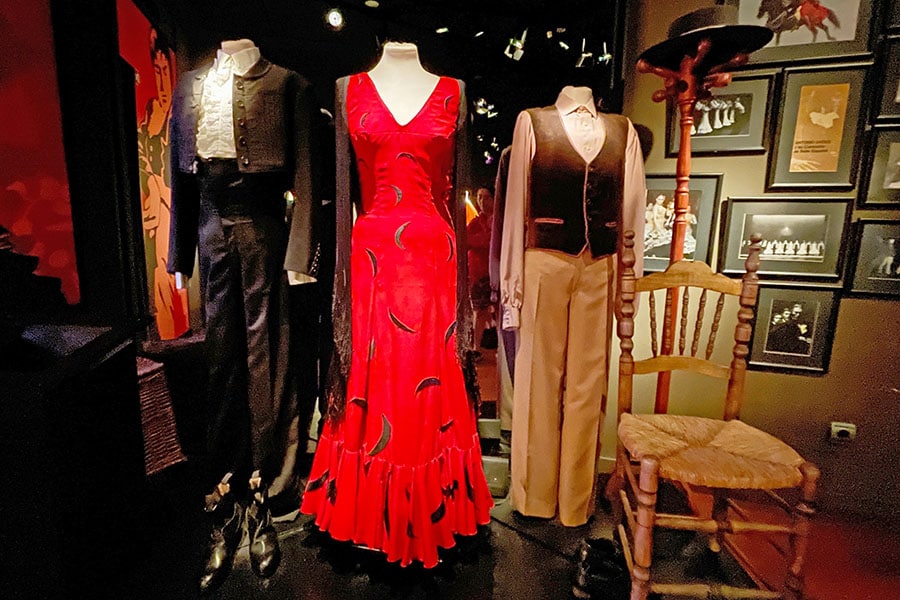 One of the highlights at ‘The Museo del Baile Flamenco,’ founded by renowned flamenco dancer Cristina Hoyos, is this red dress, that she wore during her performance at the 1992 Summer Olympics in Barcelona. Image: Veidehi Gite
One of the highlights at ‘The Museo del Baile Flamenco,’ founded by renowned flamenco dancer Cristina Hoyos, is this red dress, that she wore during her performance at the 1992 Summer Olympics in Barcelona. Image: Veidehi Gite
“The flamenco dress is unique in Spain, adapting annually to the fashion industry"s changes in textiles, prints, and styles," says Retamero. “Each collection is driven by a different inspiration, and it takes us one week to design, stitch, and complete a flamenco dress. Every season brings new colours, textiles, and forms." They are the best in Seville and all of Spain because they stay ahead of trends. They continuously adapt, blending current fashion with their own creative vision.
Javier Garcia, another designer, shows me an outfit from his store and remarks, “This piece is inspired by Italian design and dedicated to the renowned Spanish folk singer Lola Flores from Jerez. There’s a significant connection to the flamenco dress in this collection, which we’re preparing for an upcoming show. The materials and production processes are meticulous, with many elements crafted by hand. The fringes are made from silk crepe, and the embroidery is also done manually. Once the pattern is completed, we assemble the final outfit, ensuring every detail is perfect. Most of our fabrics are sourced from Italy, with some coming from Turkey. Currently, the trend leans towards fabrics like gazar or crepe, while many other designers opt for cotton. However, silk and organza are particularly popular right now."
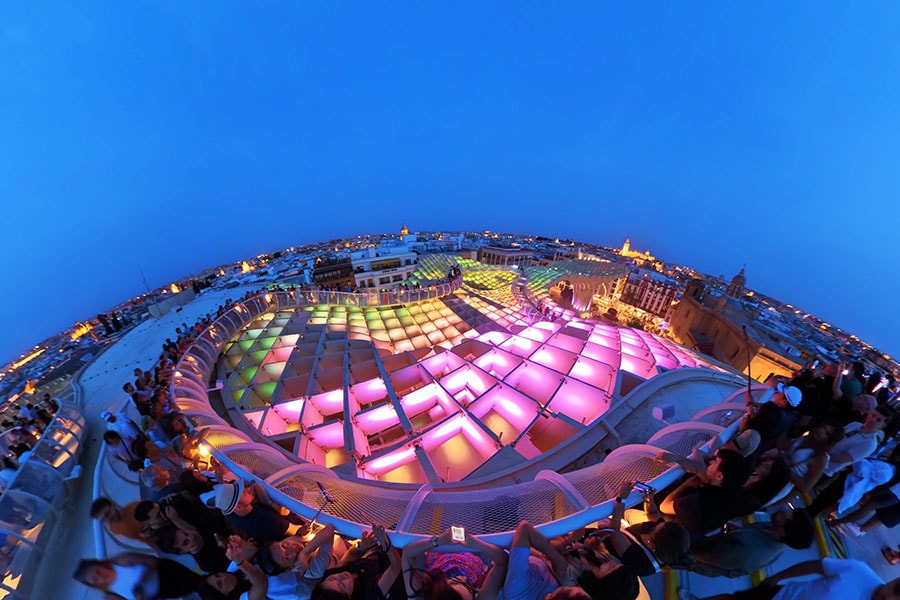 Aurora the Light of Seville at Setas de Seville is more than a light show. It balances progress, culture, and emotion, serving as a tribute to the light of Seville and offering an immersive experience beyond visual spectacle. Image: Veidehi Gite
Aurora the Light of Seville at Setas de Seville is more than a light show. It balances progress, culture, and emotion, serving as a tribute to the light of Seville and offering an immersive experience beyond visual spectacle. Image: Veidehi Gite
Before leaving, I couldn"t resist trying on one of the flamenco dresses to experience it first-hand. Despite weighing around 5 kg, the fabric felt soft against my skin, and the fit was impeccable. This year, green is the colour of choice, as noted in both Paris and Italy. Garcia, with a laugh, shared a parting thought: “In Paris, thank God, everything is sold. It"s all about upcycling now. Flamenco is a unique genre, often associated with a sense of sadness in its music and dance, but the dresses themselves don"t convey joy or sadness specifically. It"s more about the style."
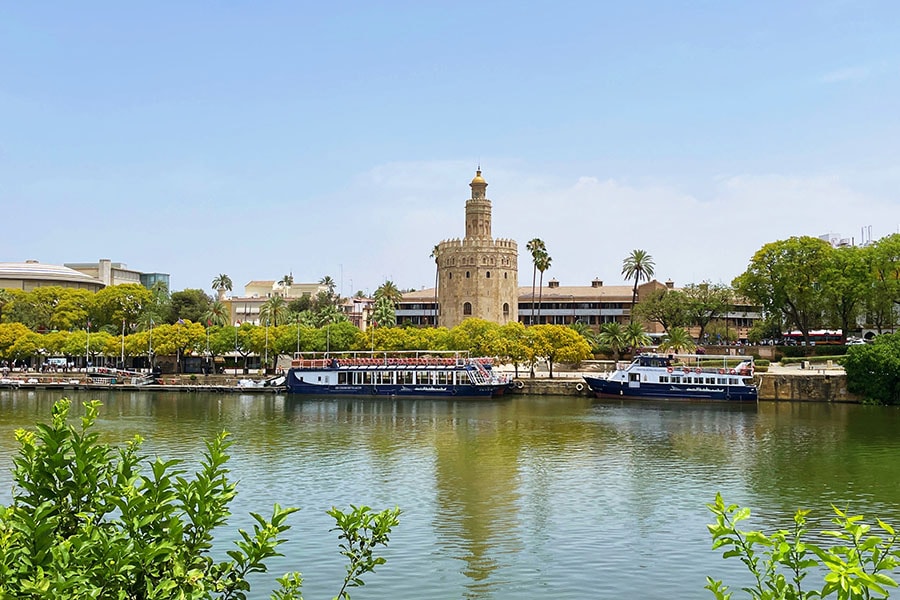 The Rio Grande restaurant offers spectacular views of the Guadalquivir Canal, Spain"s only major navigable river. The fifth-longest in the Iberian Peninsula, the Guadalquivir stretches from Seville to the Gulf of Cà¡diz and historically extended to Cà³rdoba. Image: Veidehi Gite
The Rio Grande restaurant offers spectacular views of the Guadalquivir Canal, Spain"s only major navigable river. The fifth-longest in the Iberian Peninsula, the Guadalquivir stretches from Seville to the Gulf of Cà¡diz and historically extended to Cà³rdoba. Image: Veidehi Gite
As I left Garcia"s store, my Seville guide, Javier Grillo, eagerly prepared to reveal the city"s historical treasures. His must-see list included Plaza de Espaà±a, Royal Alcà¡zar, Giralda Tower, Seville Cathedral, Plaza de Toros, Palacio de las Dueà±as, and Basilica de la Macarena. However, he insisted on one hidden gem: La Iglesia Colegial del Divino Salvador. Grillo explained that this Baroque masterpiece, dedicated to Jesus the Saviour, was originally Seville’s first mosque during the 9th century Islamic rule. After the Christian reconquest in the mid-13th century, it was consecrated as a church and transformed in the 17th century.
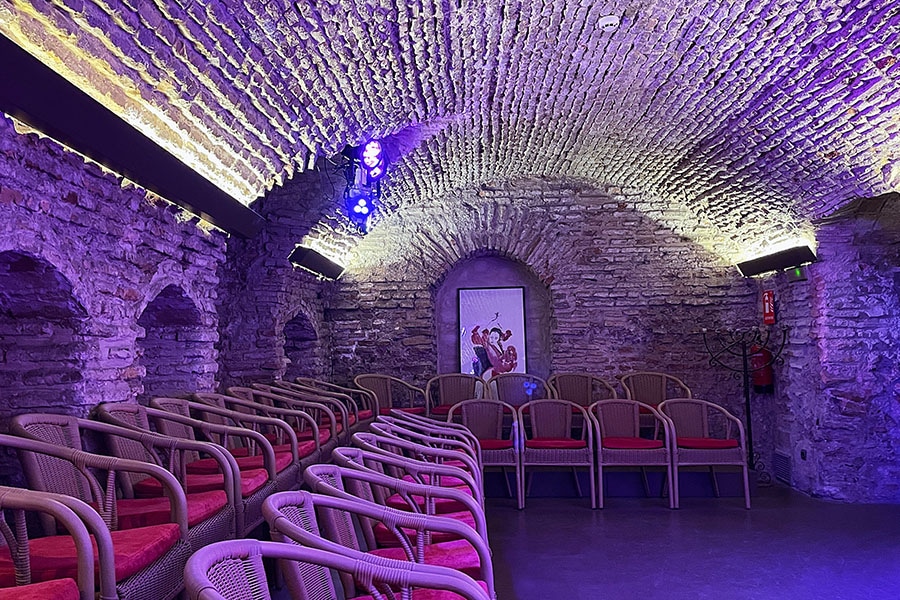 The Museo del Baile Flamenco houses Seville"s only flamenco vault, adorned with Roman stones and providing an intimate seating capacity. Image: Veidehi Gite
The Museo del Baile Flamenco houses Seville"s only flamenco vault, adorned with Roman stones and providing an intimate seating capacity. Image: Veidehi Gite
Our next stop took us off the beaten path to the Archivo de Indias. Founded by King Carlos III in 1785, this Unesco World Heritage Site is housed in a stunning 16th-century former merchant guild building. The Italian Renaissance architecture is impressive, but the real magic lies within: 43,000 folders containing 80 million pages of history and 8,000 maps, chronicling the Spanish Empire"s exploits in the Americas and Asia. To put that in perspective, laying it all out end-to-end would stretch for over six miles. The historic building is a sight, but research happens in a modern facility next door, connected by an underground tunnel.
 Famous Designer Javier Garcia flaunts the unique and modern flamenco dress of his design, weighing 15 kg and priced at EUR 1500. Image: Veidehi Gite
Famous Designer Javier Garcia flaunts the unique and modern flamenco dress of his design, weighing 15 kg and priced at EUR 1500. Image: Veidehi Gite
But Seville"s charm isn"t just in its history—it"s in its cuisine too. Across the man-made Guadalquivir canal, at Rio Grande, modern chandeliers cast a warm glow over tables set with pristine wine glasses, and long wooden doors open to a stunning view of the canal. In one corner, Pepe Baraja meticulously slices the finest Iberian ham, creating an atmosphere perfect for an authentic Spanish lunch. “The traditional cuisine of Seville is rooted in old, home recipes," says executive chef Francisco Trigo. "We rely on the proximity of Cadiz and Huelva, just an hour to an hour and a half from Seville, for our seafood. These regions are close to the Atlantic Ocean, providing us with fresh seafood. For larger seafood, we source from Galicia in the north of Spain, known for its rich and flavourful produce. At Rio Grande, we specialise in grilling the finest meats and fish."
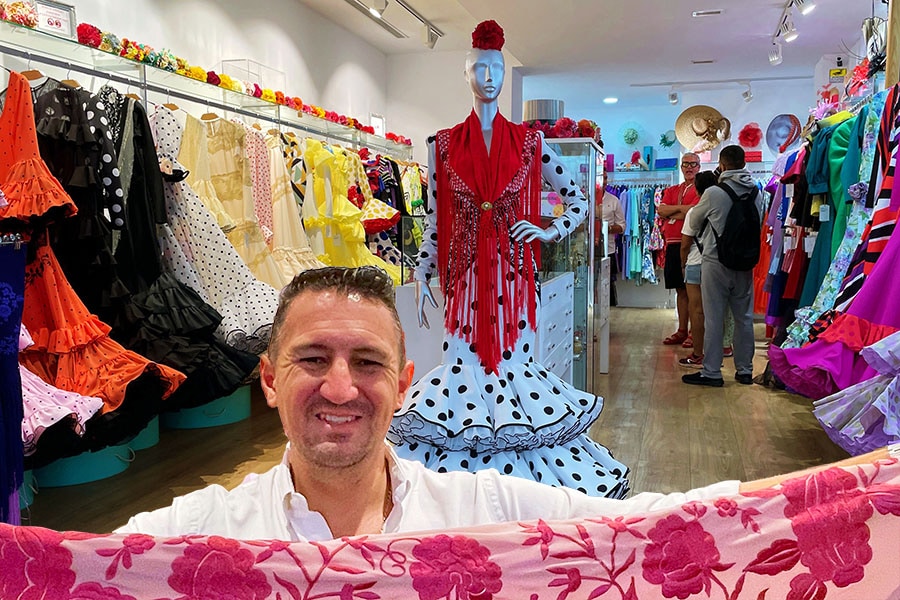 Flamenco designer Pablo Retamero displays one of his Spanish Mantà³n or Manila shawls, iconic emblems worn over flamenco dresses. Image: Veidehi Gite
Flamenco designer Pablo Retamero displays one of his Spanish Mantà³n or Manila shawls, iconic emblems worn over flamenco dresses. Image: Veidehi Gite
After a brief siesta, a cherished tradition in Spanish culture, following a multi-course Seville lunch, it was time to visit the Museo del Baile Flamenco. Juani Rojo, the manager of the Flamenco Museum, offers an insightful look into the history and evolution of flamenco, “Initially, flamenco shoes were made in France and held together with nails. Over time, the flamenco shoes evolved, along with the foot techniques such as barco nail, sapate, and tapping," she explains. Rojo delves into the origins of flamenco"s performance venues, known as tableaus or wooden boards. "Cantante Singing Cafes had stages that were not sturdy enough for the nail-studded shoes, which led to the development of harder wooden stages. This evolution marked one of the key characteristics of flamenco." In 2010, Unesco recognised flamenco as an intangible cultural heritage of humanity.
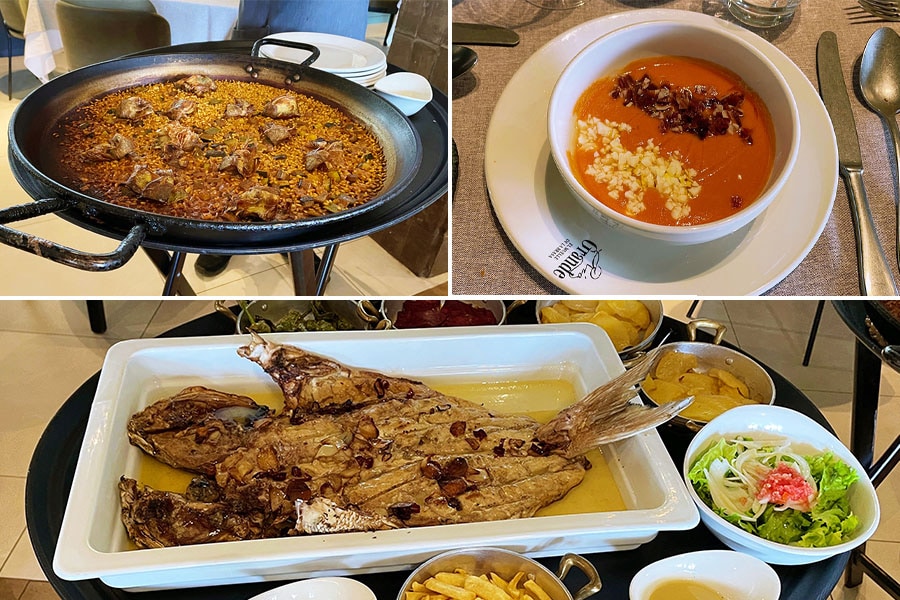 Traditional Andalusian cuisine at Rio Grande restaurant in Seville: From left to right - Paella de alcachofas (artichoke paella), Salmorejo (a traditional tomato soup), and La Corbina (grilled seabass) from Conil.
Traditional Andalusian cuisine at Rio Grande restaurant in Seville: From left to right - Paella de alcachofas (artichoke paella), Salmorejo (a traditional tomato soup), and La Corbina (grilled seabass) from Conil.
Flamenco boasts over 70 different styles, though only 12 are danceable due to complex rhythms or slow tempos. Solea, for instance, expresses deep emotions like loneliness and homesickness, reflecting flamenco"s roots in the hardships of poor people. Guajita, a flirtatious celebration of the female figure, was adopted from a Cuban country song in the 18th and 19th centuries. Farruca is a style that arrived in the 19th century from northern Spain to Andalusia, embodying elegance, power, and strength. "Originally performed only by men, Farruca is now also danced by women," Rojo notes. The evening performances typically culminate with Bulerias or Fin de Fiesta, originating from Jerez de la Frontera near Cadiz. This powerful rhythm, accompanied by encouraging shouts, marks the energetic finale of every flamenco show. Rojo adds, “Flamenco draws inspiration from diverse cultures, including Indian influences. Certain hand gestures in flamenco were introduced by gipsies of Indian descent, hailing from the Punjab region of undivided India."
First Published: Jun 22, 2024, 07:51
Subscribe Now